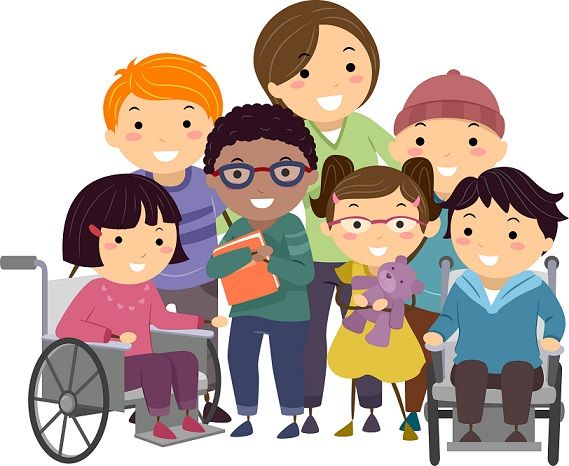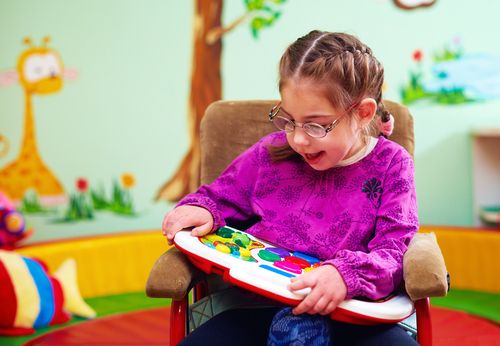 Written by Sara McEvoy, PT, DPT
Written by Sara McEvoy, PT, DPT
For kids with special needs, modifications are a necessary part of engaging and being included in their environment. In order to participate successfully in activities with their peers and their communities, certain changes may need to be made to the environment.
These modifications should reasonably yet effectively meet their needs—whether physical, cognitive, or both—without infringing on the ability of other people to access these spaces as well.
In effect, this is what it means to make a space "accessible." But an accessible space isn't necessarily just one which can accommodate a person in a wheelchair or meet other guidelines as outlined by the American with Disabilities Act.
Children with special needs face many potential challenges that may require or simply benefit from unique adaptations, even if they don't use a wheelchair.
These challenges include:
Keeping these potential challenges in mind—along with identifying and answering some key questions—is paramount when preparing to make a space accessible.

Whether designing an accessible space for a child with special needs at home, at school, or elsewhere in the community, it's helpful to consider the individual child and his or her unique attributes that may require accommodation.
Consider the following questions:
Answering these questions requires an individualized approach, and not all children will benefit from the exact same type of modifications. But there are several products, technologies, and concepts available that offer valuable guidance and a great starting point.

Children with special needs often find it difficult to feed themselves with standard utensils, especially if they require a specialized diet. But the ability to feed one's self as independently as possible can provide a great sense of accomplishment and autonomy and make a big difference in a child's self-confidence. In addition, eating skills can also help a child hone other important skills like attention and fine motor coordination.
For this reason, children are often more successful at mealtime when using adaptive equipment such as:
Food-related adaptations are cost-effective and relatively easy to implement. They can also be used in multiple settings, such as home and school.
This versatility can help a child feel more comfortable with the tools, as well as promote a familiar routine which is helpful for managing behaviors and expectations.
Like eating, hygiene tasks are a great opportunity for children to learn important skills while at the same time ensuring their skin and bodies stay clean and healthy. This is particularly essential for children who have incontinence issues or require specialized equipment such as catheters, feeding tubes, and colostomy bags.
Any adaptations to a bathroom set-up must also consider the ergonomic safety of assisting caregivers. Toileting, bathing, and dressing should be set-up to promote a child's independence while also maximizing efficiency and ease of use.
The following tools are some ideas that may help:
Convenient shelving and bins for easy access to/disposal of wipes and other hygiene devices
Caregivers and parents may also want to consider making modifications to their children's clothing to make it easier for kids to dress themselves. This may include subtle and stylish features such as hidden Velcro and snap attachments.
A child with special needs may move differently compared to able-bodied or neuro-typical children his or her age—or even compared to other children with special needs.
His or her specific attributes, including flexibility, strength, tone, range of motion, and other medical, physical, or developmental characteristics, can make transitional movements challenging. It can also make certain positions, such as ring sitting on the floor, uncomfortable or unsafe.
But being able to move around the environment and go where other children go within a home or classroom promotes participation, social engagement, and learning opportunities for a child. It can also reduce the risk associated with mobility impairments, including pressure wounds, skin tears, and falls.
A number of devices can mitigate these risks and accommodate the mobility needs of a child, including:
Additionally, for children with certain developmental, mental, or perceptual deficits, movement can be an effective way to self-soothe and manage attention and behaviors. For this reason, it may be worth exploring stand-up options, exercise balls, and other devices to support movement in a way that doesn't distract other children and also maintains the child's safety.

Play is a primary means through which children learn about their world. They also provide important opportunities for self-expression, creativity, problem-solving, socialization, and the exploration of boundaries.
All children—including able-bodied, neurotypical, and special needs kids—deserve access to toys, technology, games, and activities that are engaging and enjoyable to play with.
From a rehabilitative and therapeutic perspective, toys are particularly valuable for the child with special needs, because they can help a child develop strength, coordination, endurance, range of motion, and other physical skills.
When choosing toys for an accessible space, take into consideration whether a child has any sensory difficulties. Toys with certain textures, noises, and/or lights may be more or less appealing, depending on his or her preferences and perceptual abilities.
Toys, including ones with certain technology or digital features, can also improve opportunities for children to play with their peers.
Get creative and find ways a child can use a toy safely—this may include the concurrent use of standing frames, wheelchair-accessible tables and desks, and other positioning devices.
A final thing to keep in mind: assistive technology can improve play and leisure for a child with special needs, but it can also be essential for communication. Stands, frames, and other electronic mounting systems are great ways to make it easier for a child to use his or her communication device within the constraints of his or her physical abilities.
The main goal of accessible spaces is to create an inclusive and engaging environment for all children. And it's incredibly uplifting and encouraging for parents, caregivers, and teachers to see children thrive in their environment—not to mention for the children themselves.
Adaptive equipment and environmental modifications don't have to be cost-inhibitive. To get more guidance on crafting an accessible space for a child in your life, visit RehabMart today, and be sure to check out more helpful articles like this one on Caregiver University.

Sara McEvoy, PT, DPT, is a licensed and board-certified Doctor of Physical Therapy. She has direct clinical experience within the long-term acute care and skilled nursing settings, and has a special interest in geriatrics and neurological rehab. She is also a freelance writer who creates content almost exclusively within the health and wellness fields.